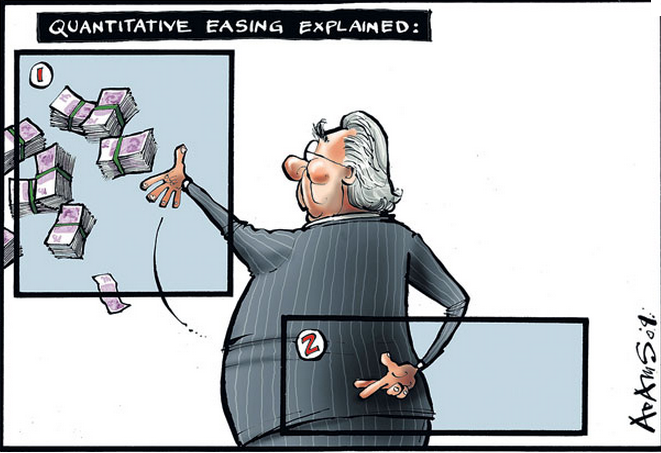
US Monetary Policy – QE4, When?
Here is the opinion of Nicolas Cheron, Econoclaste, currency analyst for FXCM, on the next move following the end of QE3 in the United States.
Since the 2008 economic meltdown, which entailed a 50 percent fall of the major international market indexes, a new system has been implemented by the central banks: administrated prices.
The Federal Reserve (Fed), the most powerful central bank in the world, has decided to change the situation. When market indexes fall, the Fed positions itself as a safeguard, and then it helps the increase by infusing our patient — the market, which without its daily drug dose — a kind of adrenaline — would not work.
The following simple graphic demonstrates my argument.
Note the correlation between the SP500 and the Fed balance sheet.
QE equals quantitative easing equals money printing equals the injection of liquidity into the — closed — financial system by fooling people into believing that it kick starts the real economy.
A bit of history:
QE1: December 2008 to March 2010
On March 18, 2009, the $600 billion plan was exhausted; Ben Bernanke, then president of the Fed, added an additional $750 billion.
QE2: November 2010 to June 2011
$600 billion more, 75 per month.
QE3: September 2012 to October 2014
Unlimited QE in terms of time and amount. Liquidity is pouring down, which is necessary to keep the indexes afloat — which have increased by 150 percent — doped up by the plethoric injections coming from the Fed, Bank of England and Bank of Japan.
Last month rang the death knell of QE3.
And what happens each time a QE stops?
The indexes fall around 10 percent.
Here is a graphic demonstration.
Therefore, in spite of the general euphoria in the U.S. markets, which have been performing at the highest annual levels following a historically powerful increase these last 15 days — a situation resembling October 2000 — I believe stock brokers should be cautious once again before buying an SP500 at 2020 points. A new correction wave should be approaching.
Notice that I need to remind you that current stock prices totally differ from the norm, that U.S. shares are overvalued; fundamentals — just as well as the markets — are rigged by administration and politics; let’s hope it stays that way ...
What can be expected? A fall in the market? The launching of a QE4? I do not know. Logic dictates that old habits die hard, that we scare ourselves on the indexes, and that central bankers rush in at the bedside of the buyers. The rules have just been modified by Japan, which has given a bullish second wind by increasing its QE from 50,000 billion to 80,000 billion Yen per year. In fact, the U.S. is not in the most critical position when compared to Japan, which, after 20 years of QE, still has not understood that it does not work.
In this regard, I need to remind you that certain Fed members have explicitly said that they did not know what long-term consequences QEs would have, since no one had tried before. Alan Greenspan, former Fed president, who can now speak, has simply anticipated a catastrophe. I second him because I am profoundly optimistic but objectively pessimistic above all.
Buyers, for four years you have been right to gamble with the dangerous QE game, but do not forget your stop buttons because when the day comes and it is correction time, prices will go in one direction.
Conclusion:
Markets will not keep themselves afloat for long without injections of liquidity.
The next fall will certainly be shored up once again by the central banks.
It is possible that the following QEs will not be used to increase the market prices but simply to avoid an implosion.
One thing left to do is cross our fingers. Like our officials.

I am curious about what US citizens think about QE? And if the American Joe felt the usefulness of such measure, in regards of, purchasing power/inflation on consumer goods etc…